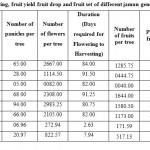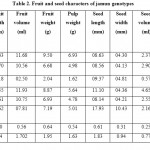How to Cite | Publication History | PlumX Article Matrix
Studies on Flowering and Fruit Characters of Jamun Genotypes (Syzygium cuminii Skeels)
Chongtham Allaylay Devi1, G. S. K. Swamy2 and Nagesh Naik2
1Department of Fruit Science, Indira Gandhi Krishi Vishwavidhyalaya, Raipur - 492012.
2Department of Fruit Science, Kittur Rani Channamma College of Horticulture, UHS, Bagalkot- 587 102.
Corresponding Author E-mail: chongthamallaylaydevi@gmail.com
DOI : http://dx.doi.org/10.13005/bbra/2368
ABSTRACT: An experiment was conducted to know the variability on flowering and physical characters of jamun genotypes (Syzygium cuminii Skeels). Observation on the flowering and physical characters of fruits were recorded on six genotypes. Significant difference was observed among the genotypes for the characters studied. Genotype AJG-58 showed early initiation of flower (Late February), maximum number of panicles(94.00), number of flowers(2983.25) and minimum duration (80.75). Genotypes AJG-20 found to be recorded maximum number of fruit (1644), number of fruit harvested (882) and fruit length (33.32) whereas maximum fruit width was recorded in Konkan Bahadoli (21.62). Maximum fruit weight and pulp weight was recorded in AJG-85 (9.50 and 6.93, respectively). Seed length (17.93) and seed width (10.43) was found maximum in Konkan Bahadoli followed by AJG-20 (11.10 and 4.36, respectively). Maximum seed weight was recorded in AJG-20(2.40) followed by AJG-85 (2.37). These two genotypes can be utilised in making jamun seed powder which is of high medicinal importance for diabetic patients. These characters could be considered as important traits for breeding programme.
KEYWORDS: Flowering; Fruiting; Seed; Syzygium cuminii
Download this article as:| Copy the following to cite this article: Devi C. A, Swamy G. S. K, Naik N. Studies on Flowering and Fruit Characters of Jamun Genotypes (Syzygium cuminii Skeels). Biosci Biotech Res Asia 2016;13(4). |
| Copy the following to cite this URL: Devi C. A, Swamy G. S. K, Naik N. Studies on Flowering and Fruit Characters of Jamun Genotypes (Syzygium cuminii Skeels). Biosci Biotech Res Asia 2016;13(4). Available from: https://www.biotech-asia.org/?p=17331 |
Introduction
Jamun (Syzygium cuminii Skeels) is an evergreen multipurpose tree. It is an important minor fruit belonging to the family Myrtaceae consisting of over 75 species and is a native of India. It has gained tremendous importance and recognition in recent past not only because of its hardy nature but also for its uncomparable medicinal and nutritional properties. The fruits are good source of iron, minerals, sugars and proteins. The vinegar prepared out of juice extracted from slightly unripe fruits is stomachic, carminative and diuretic, apart from having cooling and digestive properties (Thaper, 1958). The fruit syrup is a remedy for diarrhoea. Seed contain an alkaloid jambosin and a glycoside, jambolin or antimellin, which reduce or stop diasthetic conversion of starch into sugars.Maximum number of jamun trees is found scattered throughout the tropical and subtropical regions of the country including the Nilgiri and Himalayan region upto altitude of about 1200 meters.
Relatively long pre-bearing period and lack of recognised standard varieties are major hurdles for expansion of area under this crop. In the recent years, efforts are being made for identifying superior germplasm. Horticulture has faced vast changes, challenges and difficulties in past years. Seasonal flowering crop show a wide variation during flowering and its importance to know the per cent fruit set and fruit drop and floral behaviours.The aim of this study was to evaluate the flowering and physical charactersof six selected jamun genotypes for their suitability for cultivation under tropical climate conditions in Arabhavi (Belgaum District), India.
Materials and Methods
This study was carried out at the experimental orchard of the Department of Fruit Science, KRCCH, Arabhavi, Karnataka during February to July 2015.It lies between 16°15’ N latitude and 74°45’ E longitude, at an altitude of 612 m above mean sea level. Arabhavi lies in Zone-3, Region-2 of agro climatic Zones of Karnataka.Six promising genotypes of four years old grafted jamun tree (AJG-85, AJG-45, T.C-85, AJG-58, Konkan Bahadoli) except AJG-20 which is seven years old tree were selected.The experiment was designed with four trees from each genotypes and each tree was considered as one replicate. The data on month of flower initiation was recorded on visual observation and the treatments were arranged according to randomized complete block design (RCBD). Data on number of panicles and number of flowers was recorded by selecting four branches on each direction of each tree and the flowering density and in fruiting density the number of fruits per metre length after 30 days of full bloom. Fruit set was recorded after 30 days of full bloom. Fruits at full maturity were harvested and physical characters viz. fruit length, fruit width, fruit volume, fruit weight, seed length, seed width, seed volume, seed weight, pulp weight were determined by following standard procedures.
Results and Discussion
The data pertaining to flowering and physical characters of jamun genotypes showed significant difference and a high degree of variability for all the characters studied (Table 1 to 3). Month of flower initiation among the selected genotypes ranged from last week of February to mid-April (Table 1).Accessing the flowering characteristics are one of the important aspects for a fruit breeder. Bajpai et al.(2012) and Solomon et al. (2014) while studying on reproductive ecology found that flower bud initiation occurs in 3rdweek of February and continued till mid-May at population level.Out of the six genotypes studied, highest number of panicles and maximum number of flowers were recorded in AJG-58 (94.00 and 2983. 25, respectively) and lowest was recorded in T.C-85 (5.00 and 82.00, respectively) Table 1. The observations revealed that the genotype AJG-45 and AJG- 20 took maximum duration (91.50 and 91.25, respectively) whereas all genotypes were on par with each other (Table 1). Similar findings with respect to variability in these characters were reported by Bajpai et al. (2012)and Solomon et al. (2014).
The present study indicated that the number of fruits per tree wassignificantly highest in AJG-20 (1644.00) which was on par with AJG-58 (1580.50). Similarlymaximum number of fruit harvested per tree was recorded in AJG-20 (882.00). This variation in jamun genotypes is due to higher percentage of fruit set compared to other genotypes (Table 2).Similar finding were reported byInamdar(2000) and Prabhuraj (2001) in jamun.There was no significant differences with respect to per cent fruit set and per cent fruit drop among the different genotypes of jamun (Table 2)but the results for fruit drop may be attributed to water stress, temperature etc. prevailing in that locality. Such variations in fruit drop have been reported by (Dhillon and Gill, 2013) in pear.
Maximum fruit length was recorded in the genotype AJG-20 (33.32mm) which was on par with AJG-85 (32.57 mm). Minimum fruit length was recorded in the genotypes T.C-85 (16.33 mm). Highest fruit width was observed in Konkan Bahadoli (21.62 mm) while lowest fruit width was observed in T.C-85 (12.18mm). The fruit width of all genotypes ranged from 12.18 mm to 21.62 mm (Table 2). Maximum fruit volume was recorded in AJG-20 (11.93 ml) which was on par with AJG-85 (11.68 ml), AJG-58 (10.75 ml) and AJG-45 (10.56 ml). Minimum fruit volume was recorded in T.C-85 (2.50 ml). Maximum fruit weight was recorded in AJG-85 (9.50 g) and minimum fruit weight was recorded in T.C-85 (2.04 g). Maximum pulp weight was recorded in AJG-85 (6.93 g) which was on par with AJG-20 (5.64 g) and minimum pulp weight was recorded in T.C-85 (1.62 g) Table 2. The probable reason behind such variation in fruit breadth may be climatic variation like frequency of rainfall as well as genetic constitution of the tree (Srivastavaet al., 2006).
Maximum seed length was recorded in Konkan Bahadoli (17.93 mm) whereas minimum seed length was recorded in AJG-58 (8.14 mm).Maximum seed width was recorded in Konkan Bahadoli (10.43 mm) and minimum seed width was recorded in AJG-45 (4.13 mm). Maximum seed volume was recorded in AJG-20 (4.65 ml) and minimum fruit volume was recorded in T.C-85 (0.57 ml). Maximum seed weight was recorded in the genotype AJG-20 (2.40 g). Minimum seed weight was recorded in the genotypes T.C-85 (0.56 g).There were no significant differences among the genotypes regarding pulp to seed ratio and fruit to seed ratio (Table 3). The above observations revealed that major emphasis in selection should be higher pulp weight and fruit size (Devi et al., 2002)
Fruit weight is a dependent character which is governed by many factors, viz., fruit length, breadth, volume, size, pulp weight, pulp per cent, pulp thickness, pulp to seed ratio, seed length, breadth, volume, size, weight and seed per cent (Table 2 & 3). Interestingly, these characters which govern the fruit weight too had shown different degrees of variability in these characters andwere reported by Inamdaret al. (2002) and Prabhuraj (2002) in jamun. It is evident that the genotypes selected from Arabhavi region are best in physical characters. AJG-20 and AJG-85 was found to be superior among all genotypes for pulp weight and fruit weight.
From the present study, it can be concluded that, significant variability was observed among the six selected jamun genotypes with respect to flowering and Physical characters of the fruits. Among all the selected genotypes AJG-20 and AJG-85 were found promising with respect to physical characters which can be used in the selection and crop improvement programmes.
 |
Table 1: Flowering, fruit yield fruit drop and fruit set of different jamun genotypes |
 |
Table 2: Fruit and seed characters of jamun genotypes |
References
- Bajpai, A. and Ravishankar, H. Studies on reproductive phenology, flower biology and pollination in jamun, (SyzygiumcuminiL.).Indian J. Hort. 2012; 69 (3): 416-419.
- Devi P. S., Thangam, S. M., Desai, A.R. and ADsule, P. G. Studies on variability in physico-chemical characters of different jamun (Syzygium cuminii Skeels) accessions from Goa. Indian J. Hort. 2002; 59(2): 153-156.
- Dhillon, B. S. and Gill, B. S. Effect of climate on vegetative, flowering and fruiting behaviour of hard pear (Pyruspyrifolia) under Amritsar conditions. Asian J. Hort. 2013;8(1): 88-92.
- Ganesh, T. Fruiting patterns among canopy trees and fruit use by vertebrates in a wet evergreen forest of Western Ghats, India.PhD Dissertation, Pondicherry University, Pondicherry, India, 1990.
- Inamdar, R. Survey, evaluation of seedling progenies and standardization of clonal propagation of jamun.M. Sc. (Hort) Thesis, Univ. Agric. Sci, Dharwad, 2000.
- Misra, R.S. & P.N. Bajpai .Studies on pollination, fruit set, and fruit development in Jamun (SyzygiumcuminiiSkeel). Progressive Horticulture.1984;16: 1–5.
- Panse and Sukhatme, P. V. Statistical methods of Agricultural workers.Indian Council of Agriculture Research, New Delhi, 1967.
- Prabhuraj, H. S. Evaluation of Jamun seedling progenies and standardization of softwood grafting.M.Sc. (Hort) Thesis,Uni. Agri. Sci., Dharwad, 2001.
- Prabhuraj, H. S., Correlation and path coefficient analysis in jamun (Syzigium cuminii) trees. My Forest. 2002; 38 (2): 177-182.
- Solomon, R., Radhakrishna, J. and Hareesh, C. Reproductive ecology of Syzygium alternifolium (Myrtaceae), an endemic and endangered tropical tree species in the southern Eastern Ghats of India.J.Threatened Taxa. 2014; 6 (9): 6153-6171.
CrossRef - Srivastava, V., Rai, P. N. and Kumar, P. Studies on variability in physicochemical characters of different accession of Jamun (SyzygiumcuminiSkeels).Pantnagar J. Res. 2010; 8(1): 139-142
- Thaper, AR. Farm Bulletin, No. 42, ICAR, New Delhi, 1958.

This work is licensed under a Creative Commons Attribution 4.0 International License.





